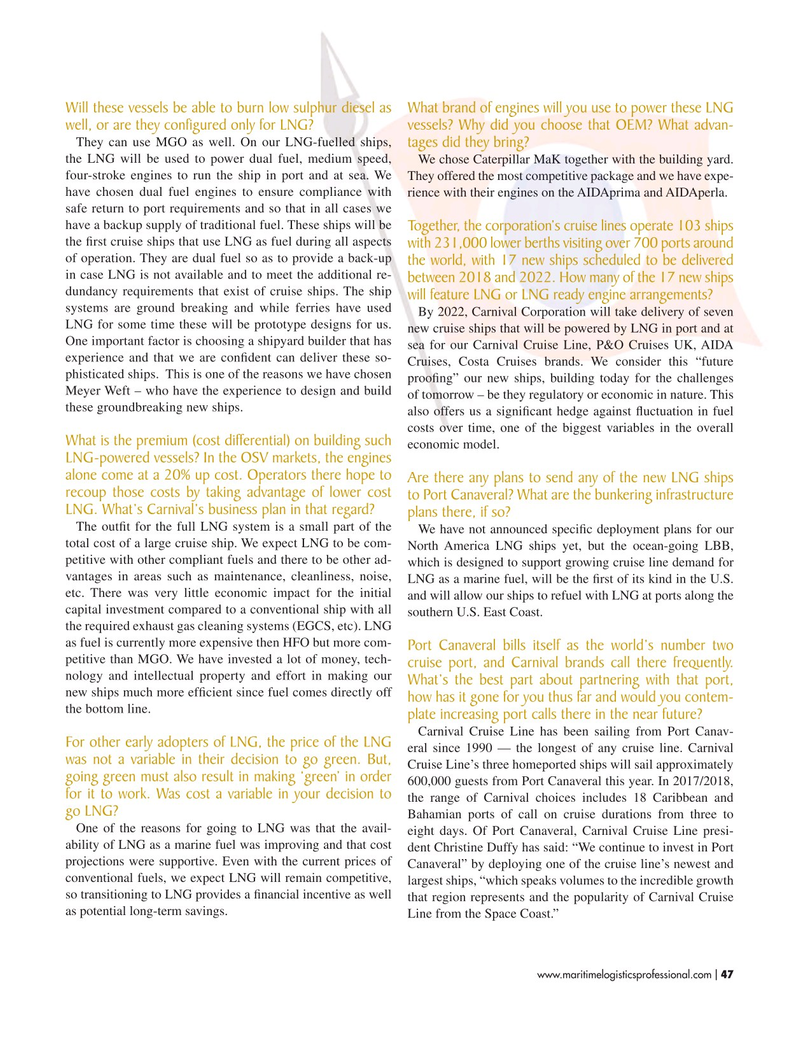
Page 47: of Maritime Logistics Professional Magazine (Jan/Feb 2018)
Cruise Shipping Trends
Read this page in Pdf, Flash or Html5 edition of Jan/Feb 2018 Maritime Logistics Professional Magazine
Will these vessels be able to burn low sulphur diesel as What brand of engines will you use to power these LNG well, or are they con? gured only for LNG? vessels? Why did you choose that OEM? What advan-
They can use MGO as well. On our LNG-fuelled ships, tages did they bring? the LNG will be used to power dual fuel, medium speed, We chose Caterpillar MaK together with the building yard. four-stroke engines to run the ship in port and at sea. We They offered the most competitive package and we have expe- have chosen dual fuel engines to ensure compliance with rience with their engines on the AIDAprima and AIDAperla.
safe return to port requirements and so that in all cases we have a backup supply of traditional fuel. These ships will be
Together, the corporation’s cruise lines operate 103 ships the ? rst cruise ships that use LNG as fuel during all aspects with 231,000 lower berths visiting over 700 ports around of operation. They are dual fuel so as to provide a back-up the world, with 17 new ships scheduled to be delivered in case LNG is not available and to meet the additional re- between 2018 and 2022. How many of the 17 new ships dundancy requirements that exist of cruise ships. The ship will feature LNG or LNG ready engine arrangements? systems are ground breaking and while ferries have used
By 2022, Carnival Corporation will take delivery of seven
LNG for some time these will be prototype designs for us. new cruise ships that will be powered by LNG in port and at
One important factor is choosing a shipyard builder that has sea for our Carnival Cruise Line, P&O Cruises UK, AIDA experience and that we are con? dent can deliver these so-
Cruises, Costa Cruises brands. We consider this “future phisticated ships. This is one of the reasons we have chosen proo? ng” our new ships, building today for the challenges
Meyer Weft – who have the experience to design and build of tomorrow – be they regulatory or economic in nature. This these groundbreaking new ships.
also offers us a signi? cant hedge against ? uctuation in fuel costs over time, one of the biggest variables in the overall
What is the premium (cost differential) on building such economic model.
LNG-powered vessels? In the OSV markets, the engines alone come at a 20% up cost. Operators there hope to Are there any plans to send any of the new LNG ships recoup those costs by taking advantage of lower cost to Port Canaveral? What are the bunkering infrastructure
LNG. What’s Carnival’s business plan in that regard? plans there, if so?
The out? t for the full LNG system is a small part of the
We have not announced speci? c deployment plans for our total cost of a large cruise ship. We expect LNG to be com-
North America LNG ships yet, but the ocean-going LBB, petitive with other compliant fuels and there to be other ad- which is designed to support growing cruise line demand for vantages in areas such as maintenance, cleanliness, noise, LNG as a marine fuel, will be the ? rst of its kind in the U.S. etc. There was very little economic impact for the initial and will allow our ships to refuel with LNG at ports along the capital investment compared to a conventional ship with all southern U.S. East Coast.
the required exhaust gas cleaning systems (EGCS, etc). LNG as fuel is currently more expensive then HFO but more com-
Port Canaveral bills itself as the world’s number two petitive than MGO. We have invested a lot of money, tech- cruise port, and Carnival brands call there frequently. nology and intellectual property and effort in making our
What’s the best part about partnering with that port, new ships much more ef? cient since fuel comes directly off how has it gone for you thus far and would you contem- the bottom line. plate increasing port calls there in the near future?
Carnival Cruise Line has been sailing from Port Canav-
For other early adopters of LNG, the price of the LNG eral since 1990 — the longest of any cruise line. Carnival was not a variable in their decision to go green. But,
Cruise Line’s three homeported ships will sail approximately going green must also result in making ‘green’ in order 600,000 guests from Port Canaveral this year. In 2017/2018, for it to work. Was cost a variable in your decision to the range of Carnival choices includes 18 Caribbean and go LNG?
Bahamian ports of call on cruise durations from three to
One of the reasons for going to LNG was that the avail- eight days. Of Port Canaveral, Carnival Cruise Line presi- ability of LNG as a marine fuel was improving and that cost dent Christine Duffy has said: “We continue to invest in Port projections were supportive. Even with the current prices of Canaveral” by deploying one of the cruise line’s newest and conventional fuels, we expect LNG will remain competitive, largest ships, “which speaks volumes to the incredible growth so transitioning to LNG provides a ? nancial incentive as well that region represents and the popularity of Carnival Cruise as potential long-term savings.
Line from the Space Coast.” www.maritimelogisticsprofessional.com 47
I

 46
46

 48
48
